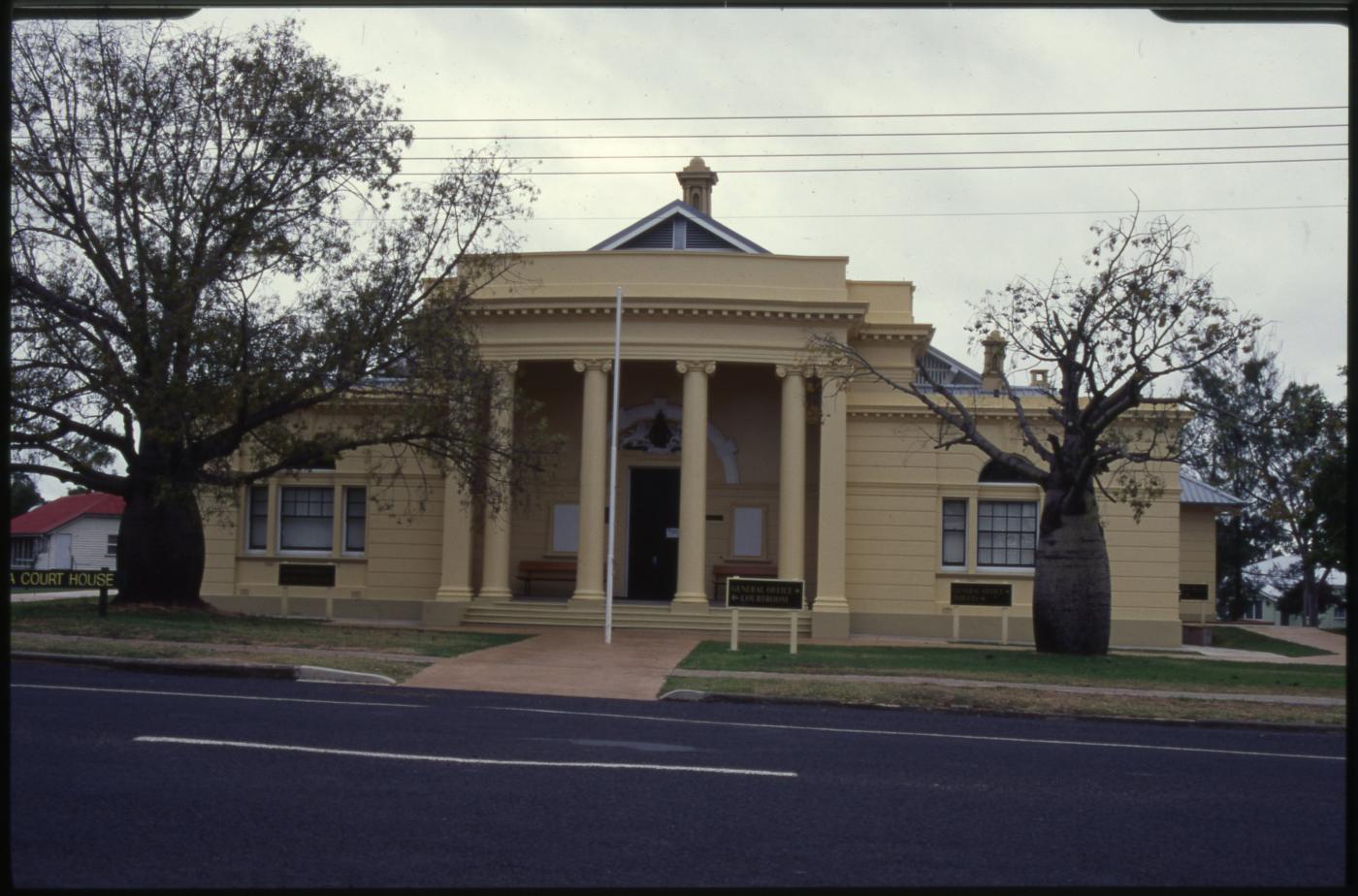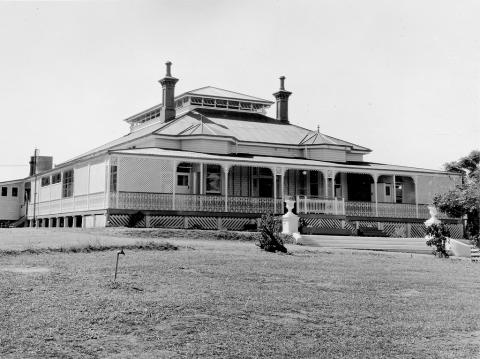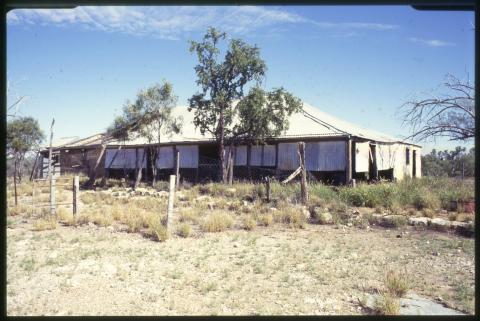
- News of the day
-
Western Star and Roma Advertiser, Saturday 11 January 1902, page 3
The New Roma Court House.
OPENED BY ATTORNEY GENERAL.
Yesterday will long be remembered in Roma as the day upon which the new Roma Court House was opened for the transaction of the public business for which it was erected. As the outcome of the meeting of the Roma Municipal Council on Tuesday evening, a meeting of local Justices of the Peace and prominent citizens was held on Wednesday, and it was decided that the occasion should be suitably observed. It was arranged that all business places should close from 11 o’clock until 1 o’clock to enable as many as possible to attend the ceremony. The court house itself was decorated with flags and greenery, and presented a very gay appearance. On the arrival of Mr. Rutledge from Mitchell, a procession – formed of the military forces, Mayor and aldermen and many buggies containing local residents, and headed by the Roma Town Band (conducted by Mr. B Kruger) – started from the railway station, and marched up McDowall Street to the site upon which the Court House stands. The interior of the building was filled with spectators, many of whom were ladies. The dais was occupied by the Attorney-General, the Mayor of Roma (Alderman Bones), Hon. James Lalor, M.L.C., Inspector Fitzgerald, Mr Cahill (Under Secretary for Justice), Mr Brady (Under Secretary for Works and Government Architect), Mr. T. A. Spencer (President of the Roma Chamber of Commerce) and others.
Before the ceremony was entered upon, Mr. Brady formally took over the building on behalf of his Department. In doing so he briefly related the particulars connected with the preparations of the plans and invitation of tenders, and described the building. He praised the acoustic properties of the court room and gave every praise to the work of Mr. Renwick (the contractor) and of Mr. P. H. Johnson (the inspector).
The Attorney-General said it must be gratifying to all that they were able to take part in a function of such an important character, one that derived its chief interest from the fact that it was entirely unconnected with anything of a political nature. The building was as perfect as human intelligence could make it, and it was very creditable for a town to have such a building in it, for visitors generally judged a town by the character of its public buildings. There were some people who questioned the good of a court-house except to magistrates and lawyers. He showed how the public, as well as magistrates and lawyers, were benefitted by the building. Male and female witnesses had now every convenience and comfort: jurymen would no longer be confined in a miserable little room for hours, but would also have a comfortable room provided them. The general public who had business with the Police Magistrate or the Clerk of Petty Sessions were provided with a room where that business could be transacted with more privacy and comfort than had hitherto been the case. He also referred in eulogistic terms to the faithful work rendered by the contractor and the inspector (Mr. Johnson). They had assembled to dedicate the building to the perfect and unbiased administration of justice. In some countries judges were elected, and had political supporters who tried to “get at” them, as was the case in politics. It would be a very difficult thing to try and convince a hard-headed British community that a judge, having an opponent as a litigant on one side, and a supporter as a litigant on the other, could give a decision that was free from personal motives. It would be a bad day for any country when the judges were elected by the people. It was necessary in the interests of the impartial administration of justice that judges should be absolutely above suspicion, and quite independent of the people who come before him. British communities glory in the fact that their judges are in a position to give impartial decisions who have been known to return verdicts against the Government and those were the men who were required. Their motto was “Fiat Justitia tuat coelum,” which was generally understood to mean “Let justice be done though the heavens should fall.” He felt that in the erection of the present building they had gone very far in advancing the glorious principle embodied in that motto. It was a source of sincere gratification to him that he could congratulate the town of Roma upon the possession of so handsome and useful a building for the purpose for which it was erected. On behalf of the Government of Queensland, and in the name of the Department of Justice, he formally declared the building open. (Applause).
The Mayor (Ald. Bones) said it afforded him great pleasure to see that such a lot of residents had made it convenient to attend the ceremony and listen to the speech that had been delivered by the Attorney-General. On behalf of the ratepayers he thanked the hon. Gentleman most sincerely for opening such a magnificent building, and also for the energy and unsparing trouble he had bone to which had resulted in the work being brought to such a satisfactory completion. (Applause.)
The proceedings were brought to a close with three cheers being given for the King and the Attorney-General, the band meanwhile playing the National Anthem.
Mr Rutledge subsequently entertained at luncheon at the Royal Hotel his worship the Mayor (Alderman Bones,) the Police Magistrate (Mr. E. F. Craven,) the Under Secretary for Justice (Mr. Cahill, the Under Secretary for Public Works and Colonial Architect (Mr. Brady), and Mr. D. McNaughton (representing the commercial community).https://trove.nla.gov.au/newspaper/rendition/nla.news-article97391930
- Background
-
In 1865, a reserve for court and police purposes was selected, on the hill west of the town centre. This reserve was bounded by McDowall, May (now Souter), Queen and Albert Streets. The latter street once connected Albert and Spencer Streets. It was on this site that the first Roma court house was completed in 1866. [From 1863 local magistrates had conducted court hearings in rented premises.] The first court house faced Albert Street, and was a small timber building, extended in 1884 to accommodate sittings of the Supreme Court in circuit.
This first court house was the site of the first meeting of the Roma Town Council on 10 August 1867. A simple concrete monument mounted with a granite tablet and plaque, commemorating this event, is located at the front of the Police Station in McDowall Street. It was erected during centenary celebrations in 1967 and was unveiled by Gwydir Laycock, former chairman of the Bungil Shire Council.
Roma flourished with the advent of the railway in the 1880s, ensuring the efficient transportation of stock and produce to the coastal ports. The vast artesian basin was tapped in Queensland in the late 1880s and early 1890s, securing an alternate water supply for cattle and sheep. Consistent with the growth of the Maronoa district was the increasing demand for justice administration. During this period cases heard in the various courts held at Roma increased from approximately 210 in 1892 to 280 in 1898.
Roma's 1866 court house was replaced in 1901 with a new building erected a little to the east, on a new reserve for court house purposes gazetted in 1900. The court house reserve was created by combining a market reserve, at the corner of McDowall and Queen Streets, with part of the Albert Street road reserve which had been incorporated with the police reserve in 1883.
Courtesy of the Queensland Heritage Register
/148.7845731,-26.5710093,7/450x450@2x.png?access_token=pk.eyJ1IjoicXNhLWRpc2NvLXFsZCIsImEiOiJjamJmdTgyZXEyeWNjMnlxZm8xcmtieHgxIn0.lmT9J5tTPKGuuccQgCVSAg)


